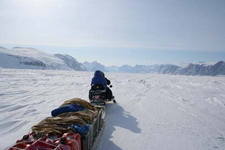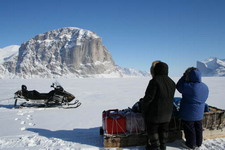Almost every local observer will explain that the sea ice is different from year to year,
but in the last decade or so, there seem to be distinct changes
Shari Gearheard
Cooperative Institute for Research in Environmental Sciences (CIRES)
University of Colorado at Boulder
 |
| Inuit and other indigenous peoples of the Arctic travel the sea ice by snow machine and by dog team. |
Many indigenous communities in the Arctic rely on sea ice for travel and hunting. Constant use of the ice over centuries has helped to build a tremendous knowledge base about ice characteristics, processes, and changes. Today, indigenous peoples of the Arctic possess traditional knowledge of ice passed down to them through the generations, knowledge they combine with their own observations and experiences to create an intimate connection with ice.
Indigenous communities in different parts of the North are observing changes in sea ice. Almost every local observer will explain that the sea ice is different from year to year, variability is always a part of the Arctic environment, but in the last decade or so, there seem to be distinct changes. The changes depend on the location and it is not always clear when the changes started to happen. But for indigenous peoples who know the sea ice, there are clear indications that the sea ice is changing, and changing rapidly.
For example, Iñupiat in Barrow Alaska have observed that summer pack ice has been unusually far offshore since the late 1990s. This change has reduced hunting opportunities at the ice edge for species such as walrus. Prior to the late 1990s, the pack ice would move in frequent intervals to near shore during summer and fall, but this has now become a rare occurrence. In addition to the impacts on hunting, the summer retreat of sea ice also leaves the coastline more vulnerable to erosion from storms and wave action. This effect is exacerbated by the absence of shorefast ice in fall due to later freeze up.
 |
| Ilkoo and Kalluk Angutikjuak of Clyde River, Nunavut, take a break from ice travel to admire the scenery. |
Many Inuit communities in Nunavut, Canada, are noticing changing sea ice conditions as well. In addition to earlier breakup and later freezeup in some areas, Inuit provide great insights into the finer details of sea ice change, including changes in the condition and characteristics of the sea ice itself. For example, many hunters and Elders describe the sea ice as being “softer” than usual. This softness is detected by observing the way ice responds to being struck with a harpoon. This technique has been used for generations to test the quality and safety of ice and is still practiced today. Experienced Inuit know the way the sea ice should feel and how it should sound during a particular season when the harpoon strikes. In recent years, the ice has been “too soft” compared to how it would normally feel during this test. There could be many reasons for the change, but Inuit suggest that the changes in break up and freeze up timing, changes in wind and snow conditions, changes in seasonal timing and temperature, and changes in ocean currents all have some role to play.
Inuit in Greenland are also noticing changes in sea ice. For example, at Qaanaaq, sea ice has been thinner than usual and aakkarnaq (ice thinned by ocean currents) occurs earlier in the year than expected. Shorefast ice that used to break up gradually from the floe-edge towards the land now breaks off all at once.
There are many other examples of indigenous observations of sea ice change from many communities across the North. So far, community members seem to be coping with changes, but there is some uncertainly about the future depending on if the changes continue and at what rate. Indigenous people continue to observe the changes and many are collaborating closely with scientists in order to understand the nature and changes of sea ice and many other aspects of the Arctic environment. This collaboration between indigenous and scientific knowledge is key to providing the most detailed picture of Arctic change, the present and potential impacts, and the responses that will need to be made.
References and other information
- Aporta, C. (2002).
- Life on the Ice: Understanding the codes of a changing environment. Polar Record, 38:341-354.
- Fox, S. (2003).
- When the Weather is Uggianaqtuq: Inuit Observations of Environmental Change. A multi-media, interactive CD-ROM. Produced at the Cartography Lab, Department of Geography, University of Colorado at Boulder. Distributed by the National Snow and Ice Data Center (NSIDC) and Arctic System Sciences (ARCSS), National Science Foundation.
- Gearheard, S., Matumeak, W., Angutikjuaq, I., Maslanik, J., Huntington, H.P., Leavitt, J., Matumeak-Kagak, D., Tigullaraq, G., and Barry, R.G. (2006).
- “It’s Not That Simple”: A Comparison of Sea Ice Environments, Uses of Sea Ice, and Vulnerability to Change in Barrow, Alaska, USA, and Clyde River, Nunavut, Canada. Ambio Vol., 35(4):203-211.
- Huntington, H.P., and Fox, S. (2005).
- The Changing Arctic: Indigenous Perspectives. Chapter 3 in Arctic Climate Impact Assessment (ACIA). Cambridge University Press, pp. 61-98.
- Krupnik, I. (2002).
- Watching Ice and Weather Our Way. In, I. Krupnik and D. Jolly, (eds.) The Earth is Faster Now: Indigenous Observations of Arctic Environmental Change. Fairbanks, AK: Arctic Research Consortium of the United States, p. 157-199.
- Krupnik, I., and D. Jolly, eds. (2002).
- The Earth is Faster Now: Indigenous Observations of Arctic Environmental Change. Fairbanks, Alaska: Arctic Research Consortium of the United States. xxvii + 356p.
- Meier, W.M, Stroeve, J., and Gearheard, S. (2006).
- Bridging Perspectives from Remote Sensing and Inuit Communities on Changing Sea Ice Cover in the Baffin Bay Region. Annals of Glaciology, Vol. 44, in press.
- Nichols, T., Berkes, F., Jolly, D., Snow, N.B., and the Community of Sachs Harbour (2004).
- Climate Change and Sea Ice: Local Observations from the Canadian Western Arctic. Arctic, 57(1):68-79.
http://www.uaf.edu/olcg/globalchange/climate.change.html
Photographs provided by Shari Gearheard.
11/1/2006




